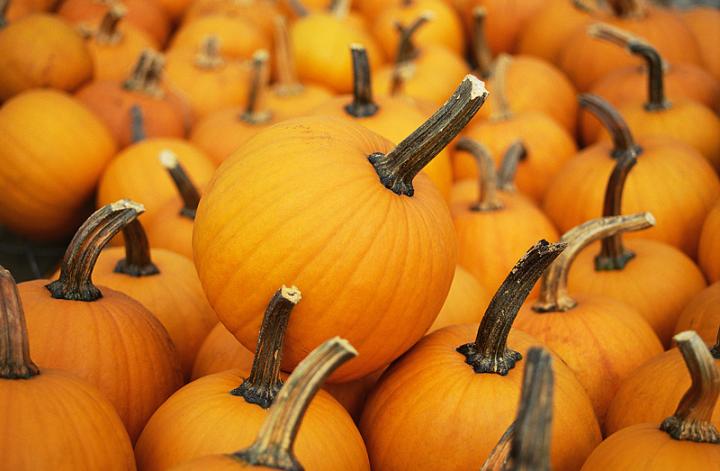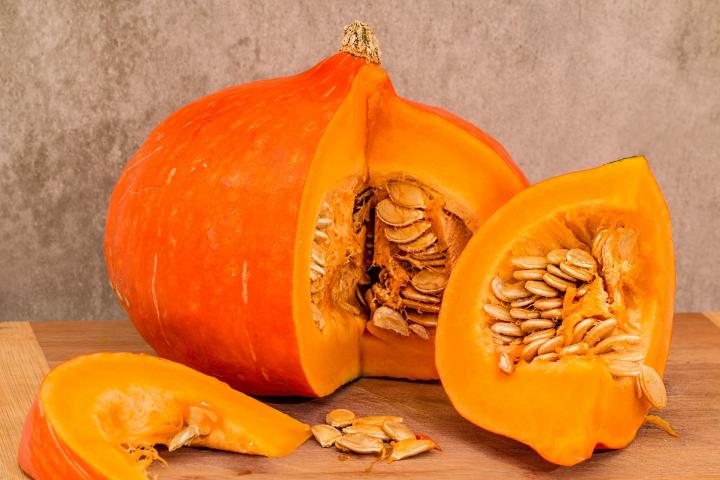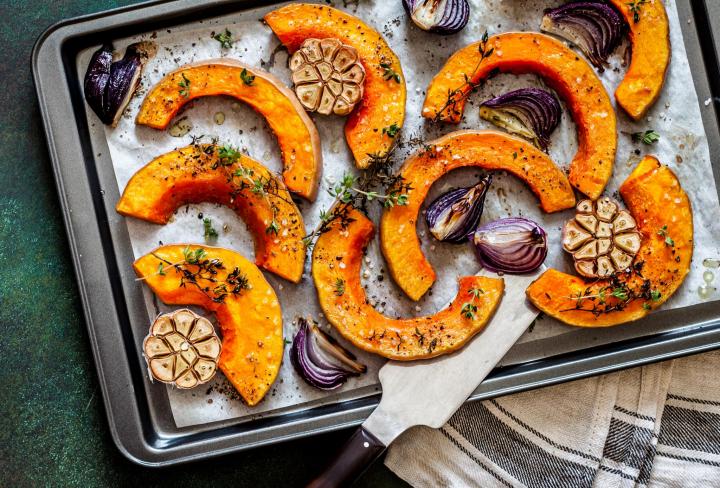Time to turn to pumpkins and sweet, orange-fleshed hubbards, buttercups, butternuts, and acorns for comfort. Winter squash is a nutritional powerhouse—packed with vitamins and minerals. Let’s get your pumpkin on with these impressive health benefits.
What Is Winter Squash?
Native to the New World, all varieties of squash and pumpkins belong to the genus Cucurbita within the large plant family Cucurbitacae.
“Summer” squashes are varieties of squash bred to be eaten as tender, immature fruits, as distinguished from “winter” squash, whose orange- or yellow-fleshed fruits are allowed to mature fully. Pumpkins are a type of winter squash, though we treat them a little differently, given their popularity!
Many of the hard-rinded hubbards, butternuts, buttercup, and kabocha types will keep six months or more if free from injury, properly cured, and stored in a cool (50° to 55°F), dry space.
Every kind of winter squash is versatile: try it baked, steamed, puréed into a creamy soup, or added in chunks to a stew, casserole, or winter salad. Bake it into pies and muffins, and even add puréed squash to smoothies.
And don’t throw out the skins and seeds*. All parts of winter squash and pumpkin fruit are edible, except for the stem.
Plus, they’re really good for you!

Photo: Butternut Squash
Pumpkin and Squash Health Benefits
For centuries, winter squash and pumpkin seeds have been valued not only for their protein content and healthy blend of oils, but also for their medicinal value.
Winter squash is a top source of Vitamin A due to its carotenoid richness! Just one cup supplies 59% of your daily Vitamin A requirement! It’s also a very good source of Vitamin C, fiber, several of the B complex vitamins, potassium, and many other essential minerals.
Indeed, winter squash contains high amounts of several carotenoids, a class of more than 600 plant pigments manufactured by plants for their own protection that give many fruits and vegetables their orange or yellow tinge. While some carotenoids convert to Vitamin A in the body, others may play a role in cancer prevention, blood sugar control, and immune function.
Although most of their calories come from carbohydrates, winter squash contain a special class of carbohydrates that have anti-inflammatory and antioxidant, as well as cholesterol- and insulin-regulating properties.
Besides being packed with vitamins and minerals, pumpkin and winter squash are also relatively low in calories.
See more about winter squash’s health benefits.

Image: “Sugar” or “pie” pumpkins are best for cooking and are easily found in most grocery stores.
Pumpkins for Beauty
Pumpkin is packed full of vitamins, including Vitamin A, C, and E. It will reduce damage caused by free radicals, fight acne, and hydrate your skin.
Got dry skin, especially with indoor heat and cold weather?
Try this face mask! All you need is 1 pumpkin wedge and 1 tablespoon olive oil.
- Chop up the pumpkin into 10 cubes and boil in water for 10 minutes. Drain, mash, and let cool.
- Combine 2 tablespoons of mashed pumpkin with the olive oil and mix well.
- Application: Gently apply this to your face and neck and relax for 15 to 20 minutes. Rinse off with warm water, then apply your moisturizer.
If you wish, you can also add other ingredients such as honey, nutmeg, and/or cinnamon to your mashed pumpkin. Nutmeg is anti-inflammatory and helps reduce pore size. Cinnamon is an antiseptic that cleanses your pores. Honey is anti-fungal and calms your skin. Honey can also help make the mask a little stickier.
Choosing Pumpkin and Winter Squash
When buying winter squash, choose one that’s heavy for its size, has a hard rind, and is free from soft spots. Don’t worry about warts and brown ridges.
Note that there are decorative carving pumpkins and cooking pumpkins. The most common cooking pumpkin (which you’ll find in the grocery store) is called a “pie pumpkin” or “sugar pumpkin.” It’s a round, smaller, sweeter pumpkin than your typical decorative pumpkin. Either type is edible, but sugar pumpkins are more meaty, less stringy, and more suited to recipes!
→ See how to cook a pumpkin!
If you have grown or come into a lot of extra pumpkins or hard-shelled winter squashes this fall, your best storage option is leaving them whole until you’re ready to use one. Set them so they don’t touch each other on wooden pallets or a few thicknesses of newspapers in a cool (50º to 55ºF), dry location.

Image: Hokkaido pumpkin is also good for cooking. The inside is fleshy and delicate. The rind is edible so no peeling needed.
The Best Way to Eat Winter Squash
Baking Squash
Our favorite way of eating the buttercup-type squashes that we grow:
- Wash, halve, remove seeds, and cut the squash into wedges.
- Brush oil or butter onto the skin side, add a bit of maple syrup and half-an-inch of water to the baking dish, cover, and bake at 350°F until a knife pierces the skin easily.
- Then eat, skin and all.

Roasting Pumpkin
Roasted pumpkin is fantastic. It delivers that creaminess in the middle with a crispy outside.
- Heat over to 400°F. Place 1-inch thick slices of pumpkin on baking sheet.
- Rub olive oil on both sides of pumpkin. Season with salt, spices, and brown sugar as you wish.
- Roast for 18 to 20 minutes.
Cooked pumpkin also freezes well. You can bake, steam, or boil them; drain well, mash or leave as cubes, and freeze for later use.
Recent research shows that it isn’t safe to can mashed or puréed pumpkin or pumpkin butter, even in a pressure canner. If you insist on canning your pumpkins, can them as cubes.
When it comes to pumpkins, don’t just think about sweet treats but remember pumpkin is great for savory recipes, too. Think pumpkin pasta, pumpkin burgers, pumpkin quiche, and pumpkin hummus. See both sweet and savory pumpkin recipes here.
So, go orange this autumn—it’s so very good for you!













